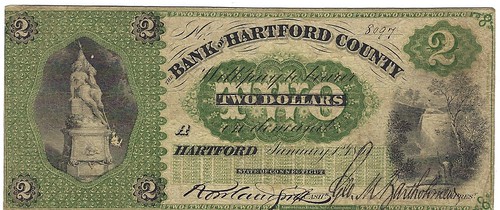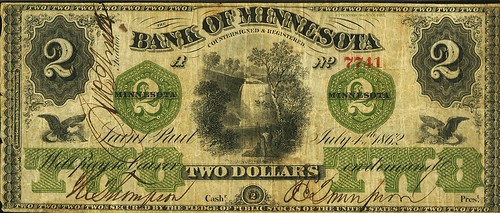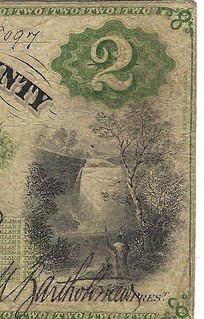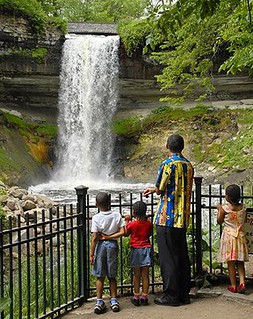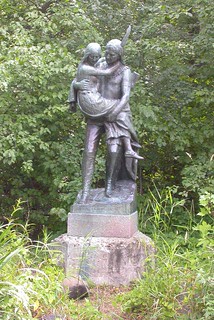
PREV ARTICLE
NEXT ARTICLE
FULL ISSUE
PREV FULL ISSUE
V25 2022 INDEX E-SYLUM ARCHIVE HIAWATHA-MINNEHAHA BANKNOTE VIGNETTEThe New England Numismatic Association's official publication is NENA News. John Ferreri offered to share some articles with E-Sylum readers. This one written by John himself shows how he was able to use a numismatic book illustration to identify characters in a vignette on an obsolete banknote. Great work! -Editor
Identities of Two Fictitious Native American Characters Come to Light
in Vignettes on Obsolete U. S. Paper Money
Paper money vignettes often pose identification problems. While
some actually have the title of the artwork engraved alongside the vignette, this is not always the case. Sometimes a vignette was chosen and
the description omitted or misplaced, because it just was not important to
that particular bank. The bank note above is striking, especially with the
large green counter
Identifying the subjects on the face of state-sanctioned or
However, the people and events depicted in the vignettes were
mostly not identified in writing on the note(s) itself/themselves. The
owners of these bills, if interested at all, would have needed a good store
of knowledge to figure out what he or she was actually looking at. How
could the average Joe know that he was looking at an engraving of The banknote at the head of this article features an intricately engraved waterfall scene as one of the two main vignettes. This attractive note was issued by the Bank of Hartford County in Hartford, Connecticut. One quickly notices the two Native American figures, with the male figure standing in front of the waterfall, and the female seated on the ground next to him. This is not as common a vignette as often appears on most notes issued by this bank. As hard as I tried, I couldn't attribute the rustic vignette to an area of Hartford or even that general area of Connecticut. Identifying it became a challenge that took well over a year for me to solve. Figure 3 - Close up image of the Falls that appears on the bank note Figure 4 - Close up image of the modern day falls in Regional Park Figure 5 - Banknote printer's proof of the falls Figure 6 - Statue of the two Native Amercians Without being able to locate descriptions or titles of the vignettes, neither the statue nor the waterfall could be identified initially. However, while browsing through the R. Shawn Hewett book A History and Catalog of Minnesota Obsolete Bank Notes & Scrip (2006), which features plenty of pictures of notes from Minnesota, I found a match. This vignette had also been used on $2 notes of the Bank of Minnesota in the city of Saint Paul (please see illustration above). Looking at the images of both the Hartford and St. Paul notes, I realized that the engraver in this case, American Bank Note Co. of New York, must have held title to the vignette die and was able to offer its use to any bank that wanted it. So, what waterfall was I looking at? Were those two Native Americans important to the engraved theme? Yes, they and the waterfall were very important in identifying the scene in the vignette! The waterfall's name became evident as the previously named Minnehaha Falls and then the identity of the two Native Americans came to light.
Jacob Fjelde, a Norwegian sculptor then living in Minnesota, created a plaster sculpture depicting Hiawatha and Minnehaha for the Minnesota Building at the 1893 World's Columbian Exhibition in Chicago. A bronze version of Fjelde's work was placed in Minnehaha Park above the falls in 1912. I was later surprised to note that the vignette (Minnehaha Falls) used on these notes had never before been attributed or identified on paper money or in any of the paper money references as I am now doing in this issue of NENA News. There is no mention of it in either the Hewett book or its predecessor, Minnesota Obsolete Notes and Scrip by R.H.Rockholt, 1973. While I have not been able to find corroborating proof of the two Native subjects' identity in the engraved scene in the U.S. Obsolete Bank Notes book, it certainly seems reasonable to claim that these vignettes show the fictitious characters, Hiawatha and Minnehaha of Longfellow's poem posing at the base of Minnehaha Falls in Minneapolis. The area around the falls and along the creek is now a preserve in the city of Minneapolis named Minnehaha Regional Park. The fact that the park, the poem, and the vignettes are intertwined makes for a beautiful American story. Longfellow never actually visited this site, but if he knew his poem was the cause of his two subjects being included in this banknote vignette I'm sure he would have been pleased. John adds: "I have since noticed a third banknote with the same vignette. It was from a state close to Minnesota. But, still no identification of the vignette."
For more information on the New England Numismatic Association, see:
Wayne Homren, Editor The Numismatic Bibliomania Society is a non-profit organization promoting numismatic literature. See our web site at coinbooks.org. To submit items for publication in The E-Sylum, write to the Editor at this address: whomren@gmail.com To subscribe go to: https://my.binhost.com/lists/listinfo/esylum All Rights Reserved. NBS Home Page Contact the NBS webmaster 
|
